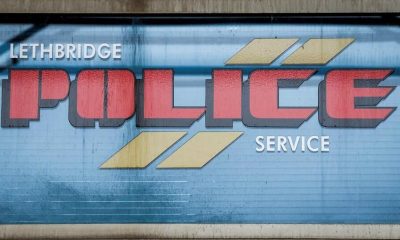Art
How to Write AI Art Prompts Effectively (with Examples)
The key to quality artificial intelligence art generator output is well-thought-out prompts. Generating AI art goes beyond slapping a few words together. It requires precision, imagination and a deep understanding of what you want the AI to create.
While basic prompts can give you quality results with generative AI tools like ChatGPT, Google Bard and other text-generative AI tools, text-to-image prompts require you to be specific in your requests to get the best results. This often means needing to understand what you want the end result to be and knowing how to describe the details, framing and lighting to get there.
While you build your confidence in making prompts, it’s a good idea to join AI art communities or even explore AI art to see what prompts were used to generate the output.
Jump to:
Structure of an AI art prompt
AI art prompts provide the necessary instructions and context for AI art generators, enabling them to generate artwork that tells compelling stories. A well-written prompt can help you properly represent your idea, while a poorly written prompt may generate an irrelevant image.
To get the best output, enter your prompt using the structure below:
- Primary request: Opening phrase, subject, theme or content, action verb, optional descriptor, setting or context.
- Secondary request: Art form, style and artist references.
- Additional settings: Lighting, colors and framing.
The opening phrase in the primary request is optional, depending on the tool. For instance, Midjourney’s opening phrase is /imagine. Different tools might use different ways to initiate the generation of art prompts, such as /imagine, create or generate. You can also use a descriptive word as your opening phrase.
In practice, the structure above will look like this as a prompt: Create a serene landscape, painted with soft pastel colors, near a tranquil river.
Figure A shows sample results of the above prompt when used on different AI art generators.
Figure A
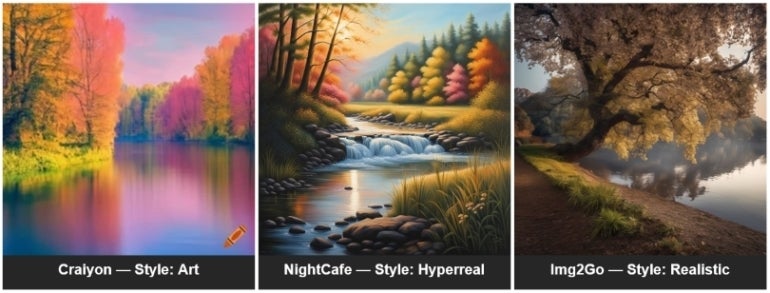
Separating each element in your prompt with a comma is important to ensure clarity and proper structure. While there aren’t any standard word or character limits for AI art prompts — different AI art generators have different upper character or word limits — it is best to keep your prompts under 100 words.
The more descriptive your prompts are, the better the AI tool will be able to produce the results. However, long prompts can confuse the AI and lead to poor results. The more words you use, the less chance the image will align with your intended output.
How to write an AI art prompt
Now that you know how to structure an AI art prompt, it’s time to put it into practice. Before you start writing your prompt, clearly envision what you want the art to convey. Think about the subject, mood, style and details necessary to your concept.
Be clear and specific
The best AI art prompts follow a specific structure, as most prompts that produce a great result share a set of common characteristics: clarity, precision and specificity. When writing an AI art prompt, start by describing the content of your image.
If you want the picture to appear in a certain way, you can add an opening phrase or descriptive words to guide the AI art generator. Some examples include:
- A pencil sketch of…
- A digital artwork of…
- A photograph of…
- A graffiti of…
- An illustration of…
Add and describe the subject
After describing your art form in the opening phrase, proceed to describe your subject, which is the image’s content. Some examples are:
- A painting of a cat: Cat is the subject.
- A digital art of a convenience store: Convenience store is the subject.
- A pencil sketch of a dog: Dog is the subject (Figure B).
Figure B
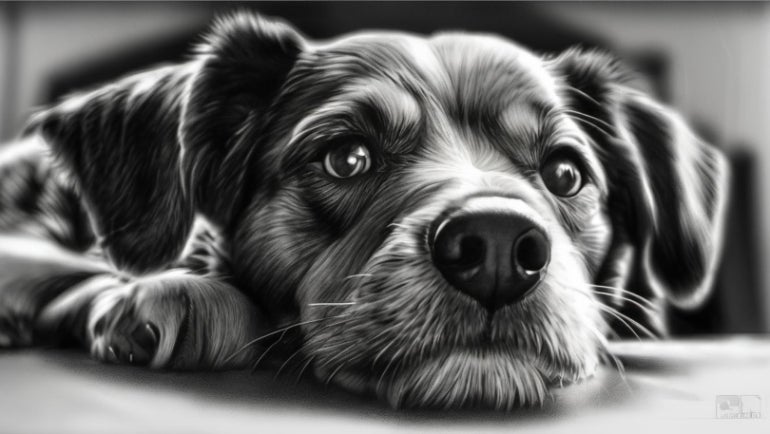
Add more details to your prompt
To make your AI art prompt more effective, include additional details that will give the AI more context and guidance. You can specify the style or mood you want the artwork to have, the colors or color palette to use, any specific elements or objects you want to include, and the composition or layout of the image.
To add life to your image, you need to add various components to your prompts.
- Action of the subject: This tells the AI what action is being taken. For example, a cat riding a bicycle.
- Action execution technique: This tells the AI how the subject is performing the actions. For example, a car riding a bicycle boldly.
- The mood of the image: The mood can be described using adjectives to convey the atmosphere or emotion of the scene. For example, a happy cat riding a bicycle with confidence.
- Background description: This provides context and setting for the image and can include details such as location, time of day, weather or any relevant elements. For example, a cat riding a blue bicycle with confidence in the rain along a peaceful road (Figure C).
Figure C
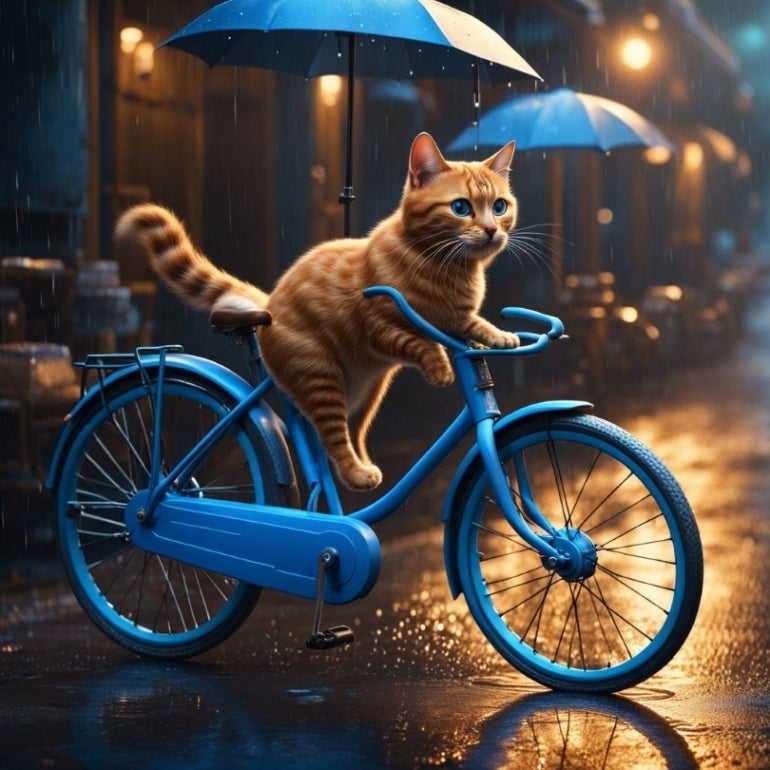
Framing and lighting
Framing refers to how a subject is positioned in the image. You can specify the desired framing style, such as close-up, wide shot or any other technique. You can even mention a preferred placement or perspective of the subject within the frame, such as centered, off-center or from a specific angle.
Lighting plays an important role in all kinds of images, AI-generated or not. The position and quality of light in relation to the subject can impact the quality of your photo or illustration, from clarity to tone and emotion. You can enhance your prompt by adding a specific lighting style like Rembrandt lighting or chiaroscuro or a lighting source such as moonlight, sunlight or even a spotlight (Figure D).
Figure D
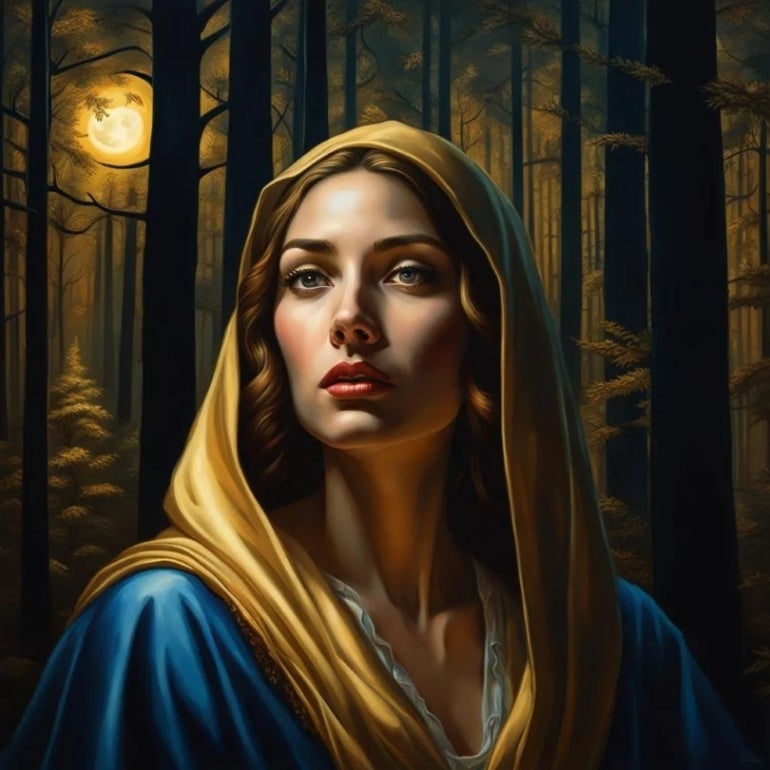
10 AI art prompt examples
Here are some AI art prompt examples to help you get started:
- An illustration of a polar bear.
- A high-resolution 3D render of Batman, cinematic lighting.
- Oil painting of a cottage near a pond, spring time.
- A futuristic cityscape at night, featuring neon lights, holographic billboards and advanced transportation.
- A digital painting inspired by a famous mythological story, such as Greek or Norse mythology.
- A 3D rendering of a futuristic cityscape at sunset, with flying cars and holographic displays.
- A picture of a person walking alone through a forest in the style of Romanticism taken from an aerial viewpoint.
- A photorealistic rendering of Michael Jackson.
- An impressionist painting of an old boot with brand neon green laces.
- Superman, cinematic lighting, realistic.
Finding AI art prompt ideas
Crafting the best AI art prompts can be challenging. It requires a lot of critical thinking. If you use a free AI generator, you may lose lots of valuable credits trying to create the perfect prompt to get your desired results; even paid tools on low plans may have limited credits.
Creating an AI prompt with primary and secondary requests and additional requirements that consider the action, mood and lighting can help you create effective prompts. And if you’d like help, you can always join AI art communities, like OpenAI’s server and Midjourney’s server, to learn how other creators craft their prompts.
PREMIUM: Consider creating an AI ethics policy before using AI art tools.
It’s also a good idea to visit AI art platforms like NightCafe and Craiyon, which allow you to see the prompts used for any of the images posted. If you’d like to leave the work completely to the machines, generative AI tools like ChatGPT, Google Bard and

Art
Calvin Lucyshyn: Vancouver Island Art Dealer Faces Fraud Charges After Police Seize Millions in Artwork

In a case that has sent shockwaves through the Vancouver Island art community, a local art dealer has been charged with one count of fraud over $5,000. Calvin Lucyshyn, the former operator of the now-closed Winchester Galleries in Oak Bay, faces the charge after police seized hundreds of artworks, valued in the tens of millions of dollars, from various storage sites in the Greater Victoria area.
Alleged Fraud Scheme
Police allege that Lucyshyn had been taking valuable art from members of the public under the guise of appraising or consigning the pieces for sale, only to cut off all communication with the owners. This investigation began in April 2022, when police received a complaint from an individual who had provided four paintings to Lucyshyn, including three works by renowned British Columbia artist Emily Carr, and had not received any updates on their sale.
Further investigation by the Saanich Police Department revealed that this was not an isolated incident. Detectives found other alleged victims who had similar experiences with Winchester Galleries, leading police to execute search warrants at three separate storage locations across Greater Victoria.
Massive Seizure of Artworks
In what has become one of the largest art fraud investigations in recent Canadian history, authorities seized approximately 1,100 pieces of art, including more than 600 pieces from a storage site in Saanich, over 300 in Langford, and more than 100 in Oak Bay. Some of the more valuable pieces, according to police, were estimated to be worth $85,000 each.
Lucyshyn was arrested on April 21, 2022, but was later released from custody. In May 2024, a fraud charge was formally laid against him.
Artwork Returned, but Some Remain Unclaimed
In a statement released on Monday, the Saanich Police Department confirmed that 1,050 of the seized artworks have been returned to their rightful owners. However, several pieces remain unclaimed, and police continue their efforts to track down the owners of these works.
Court Proceedings Ongoing
The criminal charge against Lucyshyn has not yet been tested in court, and he has publicly stated his intention to defend himself against any pending allegations. His next court appearance is scheduled for September 10, 2024.
Impact on the Local Art Community
The news of Lucyshyn’s alleged fraud has deeply affected Vancouver Island’s art community, particularly collectors, galleries, and artists who may have been impacted by the gallery’s operations. With high-value pieces from artists like Emily Carr involved, the case underscores the vulnerabilities that can exist in art transactions.
For many art collectors, the investigation has raised concerns about the potential for fraud in the art world, particularly when it comes to dealing with private galleries and dealers. The seizure of such a vast collection of artworks has also led to questions about the management and oversight of valuable art pieces, as well as the importance of transparency and trust in the industry.
As the case continues to unfold in court, it will likely serve as a cautionary tale for collectors and galleries alike, highlighting the need for due diligence in the sale and appraisal of high-value artworks.
While much of the seized artwork has been returned, the full scale of the alleged fraud is still being unraveled. Lucyshyn’s upcoming court appearances will be closely watched, not only by the legal community but also by the wider art world, as it navigates the fallout from one of Canada’s most significant art fraud cases in recent memory.
Art collectors and individuals who believe they may have been affected by this case are encouraged to contact the Saanich Police Department to inquire about any unclaimed pieces. Additionally, the case serves as a reminder for anyone involved in high-value art transactions to work with reputable dealers and to keep thorough documentation of all transactions.
As with any investment, whether in art or other ventures, it is crucial to be cautious and informed. Art fraud can devastate personal collections and finances, but by taking steps to verify authenticity, provenance, and the reputation of dealers, collectors can help safeguard their valuable pieces.
Art
Ukrainian sells art in Essex while stuck in a warzone – BBC.com
[unable to retrieve full-text content]
Ukrainian sells art in Essex while stuck in a warzone BBC.com

Source link
Art
Somerset House Fire: Courtauld Gallery Reopens, Rest of Landmark Closed
The Courtauld Gallery at Somerset House has reopened its doors to the public after a fire swept through the historic building in central London. While the gallery has resumed operations, the rest of the iconic site remains closed “until further notice.”
On Saturday, approximately 125 firefighters were called to the scene to battle the blaze, which sent smoke billowing across the city. Fortunately, the fire occurred in a part of the building not housing valuable artworks, and no injuries were reported. Authorities are still investigating the cause of the fire.
Despite the disruption, art lovers queued outside the gallery before it reopened at 10:00 BST on Sunday. One visitor expressed his relief, saying, “I was sad to see the fire, but I’m relieved the art is safe.”
The Clark family, visiting London from Washington state, USA, had a unique perspective on the incident. While sightseeing on the London Eye, they watched as firefighters tackled the flames. Paul Clark, accompanied by his wife Jiorgia and their four children, shared their concern for the safety of the artwork inside Somerset House. “It was sad to see,” Mr. Clark told the BBC. As a fan of Vincent Van Gogh, he was particularly relieved to learn that the painter’s famous Self-Portrait with Bandaged Ear had not been affected by the fire.
Blaze in the West Wing
The fire broke out around midday on Saturday in the west wing of Somerset House, a section of the building primarily used for offices and storage. Jonathan Reekie, director of Somerset House Trust, assured the public that “no valuable artefacts or artworks” were located in that part of the building. By Sunday, fire engines were still stationed outside as investigations into the fire’s origin continued.
About Somerset House
Located on the Strand in central London, Somerset House is a prominent arts venue with a rich history dating back to the Georgian era. Built on the site of a former Tudor palace, the complex is known for its iconic courtyard and is home to the Courtauld Gallery. The gallery houses a prestigious collection from the Samuel Courtauld Trust, showcasing masterpieces from the Middle Ages to the 20th century. Among the notable works are pieces by impressionist legends such as Edouard Manet, Claude Monet, Paul Cézanne, and Vincent Van Gogh.
Somerset House regularly hosts cultural exhibitions and public events, including its popular winter ice skating sessions in the courtyard. However, for now, the venue remains partially closed as authorities ensure the safety of the site following the fire.
Art lovers and the Somerset House community can take solace in knowing that the invaluable collection remains unharmed, and the Courtauld Gallery continues to welcome visitors, offering a reprieve amid the disruption.
-

 Sports20 hours ago
Sports20 hours agoEdmonton Oilers sign defenceman Travis Dermott to professional tryout
-

 Sports13 hours ago
Sports13 hours agoKirk’s walk-off single in 11th inning lifts Blue Jays past Cardinals 4-3
-

 Sports19 hours ago
Sports19 hours agoCanada’s Sarah Mitton captures shot put gold at Diamond League in Brussels
-

 Tech23 hours ago
Tech23 hours agoUnited Airlines will offer free internet on flights using service from Elon Musk’s SpaceX
-

 Media24 hours ago
Media24 hours agoWhat to stream this weekend: ‘Civil War,’ Snow Patrol, ‘How to Die Alone,’ ‘Tulsa King’ and ‘Uglies’
-

 Business23 hours ago
Business23 hours agoRoots sees room for expansion in activewear, reports $5.2M Q2 loss and sales drop
-

 News18 hours ago
News18 hours agoKamloops, B.C., man charged with murder in the death of his mother: RCMP
-

 News24 hours ago
News24 hours agoMan charged with attempted murder after Lethbridge woman bludgeoned in her sleep



















